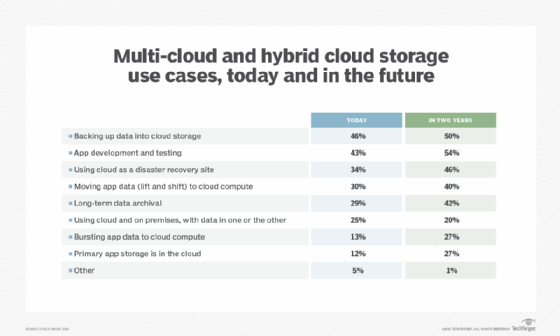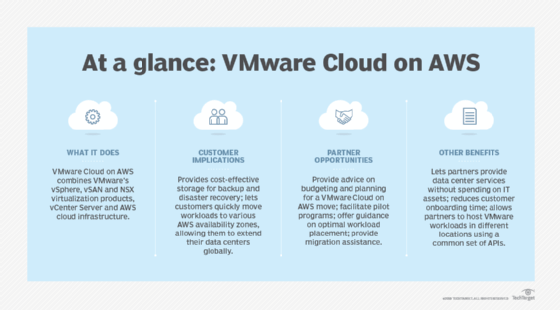
Eclipse Digital - Fotolia
Get to know these AWS hybrid cloud storage and architecture services
Use this breakdown to build a hybrid cloud strategy. Learn the ins and outs of AWS' hybrid cloud capabilities, from AWS Snowball devices to AWS Outposts and VMware Cloud on AWS.
As organizations grapple with the modern data center's increased complexity, they rely on the cloud to add capacity, deliver more on-demand services, migrate applications and eliminate manual provisioning.
Enterprises also want to keep important applications and sensitive data on premises when necessary, but with architectures, management systems and workflow processes like the ones they use for their cloud deployments. Over time, the increased viability of hybrid cloud deployments has helped solve many of these challenges. IT teams can now blend on-premises assets with public cloud services in one network space.
Amazon offers specialized tools and resources that make an AWS hybrid cloud approach viable and scalable. In this deep dive, we examine the latest hybrid cloud storage features and capabilities, including AWS Storage Gateway, AWS Outposts, AWS Snowball, AWS DataSync, Amazon Relational Database Services (RDS) and VMware Cloud on AWS.
Increase cloud flexibility with AWS Storage Gateway and Outposts
In general, enterprises build a hybrid cloud by combining on-premises or leased data centers with a public cloud. Many organizations not only maintain on-premises workloads, they rely on virtualization and cloud tools to broaden application access and ensure availability. However, storage is expensive to deploy and requires significant resources to provision and maintain.
Storage Gateway
AWS Storage Gateway provides the seamless connectivity necessary for on-premises tasks and enables virtual appliances and applications to access the AWS cloud. It simplifies access to hosted data through three types of storage gateways: file, volume and tape. AWS users set up a preferred gateway type that connects as a local disk and transfers data to the AWS cloud for backup. Customers can create endpoints to secure a gateway within an Amazon VPC or provide more open access via public gateways.
Pricing for Storage Gateway is broken into three components. File gateways accrue charges based on standard S3 pricing for storage and requests. As of publication, volume gateways cost $0.023 per GB of data stored in volumes, including point-in-time Elastic Block Store snapshots in the U.S. East regions. Tape gateways start at $0.023 per GB for virtual tape storage and $0.004 per GB for archived virtual tape storage. While archiving data is free, data retrievals cost $0.01 per GB. Organizations can utilize file compression or data deduplication to reduce their storage costs.
Administrators can use the AWS Management Console to create a storage gateway and select a host platform, such as ESXi, Hyper-V, EC2 or a designated hardware appliance. AWS Storage Gateway offers bandwidth management, automated network resilience and a highly optimized data transfer mechanism to meet the increased availability and data access needs of modern applications and workloads. The data transfer capabilities should help reduce maintenance overhead with an on-premises storage system.
AWS Outposts
Compared to Storage Gateway, AWS Outposts is a more direct hybrid cloud service. Organizations host AWS hardware and software on premises -- managed and serviced directly by Amazon. Customers order AWS Outposts through their AWS Console or via APIs, and AWS provides a fully integrated, prevalidated rack system, sized according to the customer's workload requirements.
AWS Outposts functions as an extension of an organization's cloud-based workloads and can be used to create a local gateway within a VPC and to route traffic directly to a local datacenter network. It's essentially an on-premises cloud instance that customers pay monthly service charges to utilize, which reduces their capex. It also eliminates latencies from data relays to and from the cloud, which benefits on-site functions that require single-digit millisecond latencies as well as integrations with Amazon cloud services. Examples of such compute-intensive use cases include image reviews within graphics-intensive applications, analysis of high-volume financial data or execution of real-time shop floor manufacturing processes.

Expand AWS hybrid cloud storage with AWS Snowball, DataSync and RDS
AWS offers a few different services to help customers move and manage data between on-premises data centers and the public cloud.
AWS Snowball
Organizations that need to upload petabytes and even exabytes of data to the cloud can turn to AWS Snowball, a physical migration appliance admins use to upload and ship on-premises data to Amazon, which then transfers the information to an S3 bucket. Once the transfer is complete, AWS securely erases the data from the device. Snowball guarantees speed and security, which helps IT leaders dodge the expenses and risks that can hamper large-scale data transfers.
Snowballs are well suited to migrate a range of data types, such as archival video, bulk image storage and corporate-level backups. In addition to Gigabyte Ethernet network connections, security and encryption features include 256-bit keys users can manage through the AWS Key Management Service.
Snowball pricing, at time of publication, starts with a $200 fee for the 50 TB appliance, and $250 for the 80 TB device. There is no charge for data transfer to S3, but data transfers out of Amazon's cloud vary by region and range from $0.03 to $0.05 per GB of data.
AWS also offers the AWS Snowball Edge device, which is essentially a mobile data center for data-focused field work and can be clustered for offline storage and compute capabilities. A compute-optimized version of AWS Snowball Edge provides 52 vCPUs, 208 GB of memory, 7.68 TB of NVMe SSD, and 42 TB of S3-compatible storage for compute-intensive operations in harsh environments, such as remote mining and similar offline locations. The storage-optimized version offers block storage and S3-compatible object storage, with 24 vCPUs. Both support block storage volumes up to 10 TB.
AWS DataSync
Another option for AWS hybrid cloud storage is AWS DataSync, an online data transfer service that provides fast, secure data movement through multi-part, parallel uploads. DataSync users rely on a VMware virtual appliance deployed in an on-premises network. Users connect to existing storage using Network File System (NFS) protocols and an on-premises software agent. Admins manage data transfers through the AWS Console, where they can synchronize data between on-premises NFS servers and Amazon Elastic File System on AWS.
DataSync offers maximum transfer rates of up to 10 Gbps, although it requires IT teams to manually sync tasks to keep data updated. The service is useful for one-time data migrations, repetitive data-focused processes and automatic replication for backups and disaster recovery. Admins also can use DataSync for more manageable data transfers on their own secure on-premises data center networks, rather than deploy a Snowball appliance.
Amazon RDS
Lastly for AWS hybrid cloud storage, enterprises can tap Amazon RDS to manage databases in the cloud that require high availability and automatic failover. Amazon RDS is a managed SQL database service that supports Amazon Aurora, PostgreSQL, MySQL, MariaDB, Oracle Database and SQL Server. RDS offers precise and independent scaling to expand database capabilities and provides a high degree of process automation to reduce the administrative burden of backups, patches, failure detection and recovery. While aspects of database monitoring are automated, administrators can also track performance through the RDS console. Administrators can monitor their databases with Amazon CloudWatch, which provides automated alerts to notify them when a database change occurs.
The RDS cost structure can get complicated. Key factors that can influence costs include the type of supported database engine, whether an instance is standardized or memory-optimized, whether users opt for On-Demand pricing or a range of Reserved Instance options, and whether an instance is deployed in one or multiple availability zones.
Alternatively, Amazon RDS on VMware enables customers to deploy the public, cloud-native database in their on-premises, VMware-based data centers. Users can provision databases and scale as needed. The service can be deployed and configured with vSphere clusters that run version 6.5 or newer.
VMware and AWS integration
The VMware-AWS partnership has made the hybrid cloud approach easier to manage for those that want to use both providers' tooling.
VMware's software for virtualization and private clouds is well-entrenched in data centers. Many enterprises with on-premises infrastructure run their VMs on vSphere-based private clouds, but it's not always easy to access public cloud services, resources and tools from these dedicated data center architectures.
Customers with VMware-exclusive data centers can extend the network address space for vSphere VMs via VMware Cloud on AWS, which integrates compute, storage and network virtualization, and optimizes them to run on the AWS public cloud. The service is designed for a hybrid cloud approach that employs the same VMware control plane and APIs that users regularly employ for on-premises applications. Administrators familiar with vSphere-based clouds can easily access AWS tools and resources to control applications, infrastructure and data silos in the cloud.

Both integrated hardware refreshes and infrastructure upgrades help reduce staff costs and refresh-related capex. VMware Cloud on AWS also provides an effective, cheaper disaster recovery (DR) alternative to a dedicated DR site. Customers simply allocate nodes to create the number of hosts they require.
Building on the original partnership, VMware Cloud on AWS Outposts offers as-a-service capabilities for local, on-premises management of the entire VMware SDDC. AWS provides the hardware, and VMware supplies the software and managed services. The service aims to make hybrid cloud adoption as seamless as possible for VMware customers that want to gain flexible cloud resources but also keep certain use cases on premises for low-latency LAN access or local network storage.






